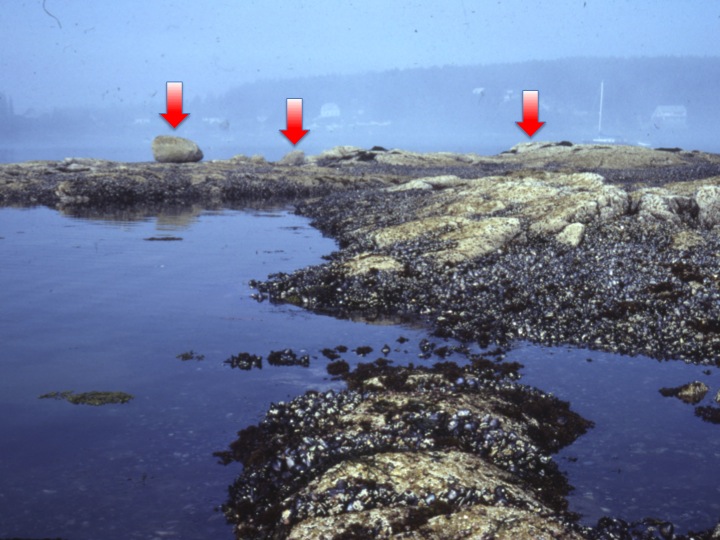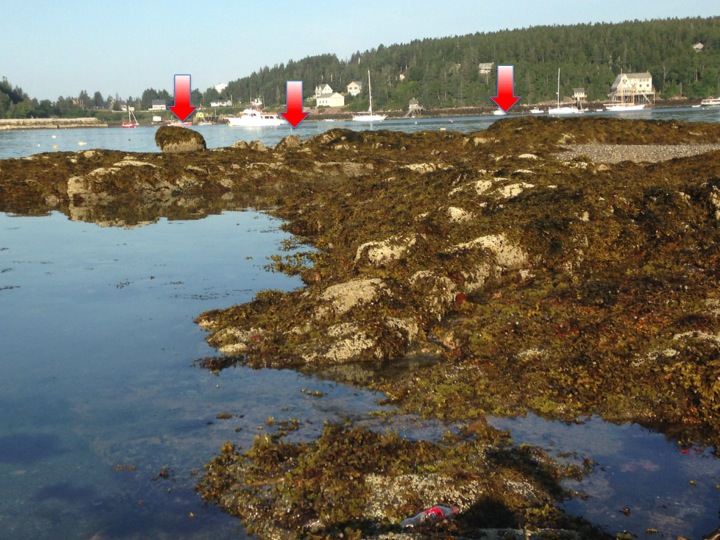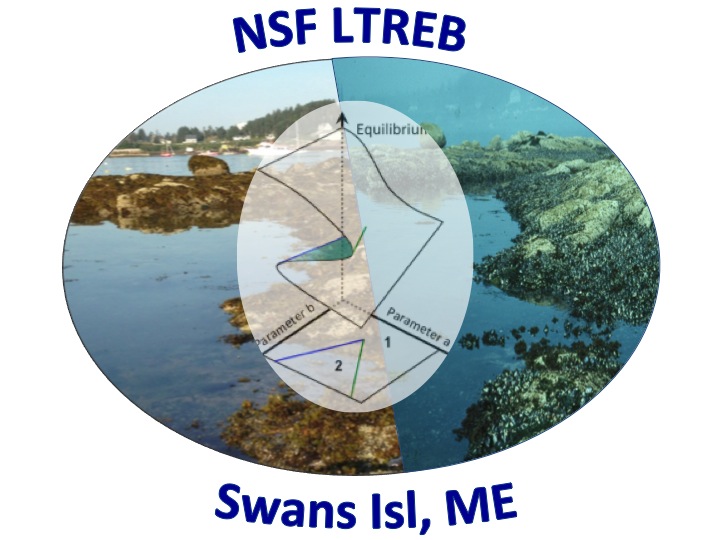Mussel beds and seaweed stands as alternative communities on rocky intertidal shores
Different ecological communities can sometimes occupy the same environment and often the same place at different times. In ecology, this idea is referred to as the theory of alternative stable states. The switch between community states can occur from small changes in environmental conditions that can unexpectedly tip an ecosystem from one community type to another. The shifts can be rapid, and communities may fail to return to the original state even when environmental conditions return to normal. Such large-scale transitions from potentially small, even temporary, environmental changes are cause for concern, especially when one community state is preferred over another.
Peter Petraitis took the photographs at the top of the page and they illustrate the phenomenon of alternative states. The two photos were taken from the same reference point looking southwest from one of our study sites at Mill Pond. The red arrows in each photo indicate landmarks for reference. The lefthand photo shows the barnacle mussel beds that occupied this site throughout the 1980's (when Petraitis began working there) and 1990's, when this project began. The righthand photo of the rockweed stand that now occupies this same site was taken in August 2015. Mussels began to decline and rockweeds began to develop in the early 2000's and the switch accelerated following large-scale natural ice scour episodes in the winter and spring of 2003.
This project tests the hypothesis that rockweed (i.e., macroalgae) stands and barnacle-mussel beds on sheltered shores in the Gulf of Maine, USA are alternative states. We are investigating the potential for rare and large-scale events, such as the destruction and removal of organisms by winter ice, to open up portions of the shore and provide the opportunity for rockweed stands to switch to mussel beds or vice versa. In the winter of 1996-97, we created experimental clearings of 1,2,4 and 8 m in diameter, and uncleared controls, that mimicked large ice events in rockweed (Ascophyllum nodosum) stands. In total, we scraped 801 square meters of rock removing approximately 22,000 kg of Ascophyllum nodosum plus associated organisms across 12 sites spread evenly among the 4 bays on Swans Island, Maine. We assayed recruitment, mortality and succession of key species in the community from 1997 to 2008. We observed some large (4 and 8 m diameter) clearings became mussel beds while others reverted to rockweed stands; a divergent pattern that is consistent with the theory of alternative stable states.
If mussel beds and rockweed stands are alternative states (i.e., community development is contingent upon historical events), we hypothesized that patterns of recruitment, mortality and succession seen in 1997-2008 would not be good predictors of subsequent recruitment, mortality and succession if the experimental plots were re-cleared. In winter 2010-11, half of our original plots were re-scraped leaving the remainder to continue succession. Repeating a controlled and replicated field experiment of this scale, to our knowledge, has not been done before. Integrated comparisons of the data before (1996-2008) and after (2010 onwards) the second experimental clearing will provide direct tests of whether prior responses of a community to perturbation predict subsequent responses at the very same site.
The pages of this website describe our experiments and sites, and provide pictures of where we work, what we do, and the data we have collected, which are available for download. Links to sites of other investigators researching similar phenomena, both, empirically and/or in theory, are also provided.





